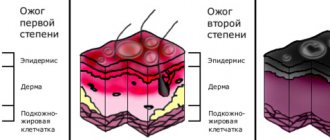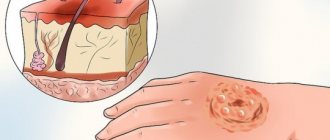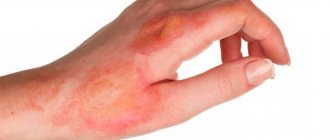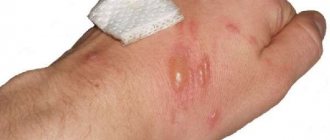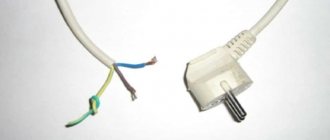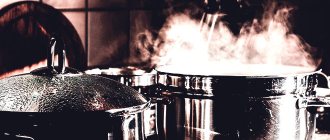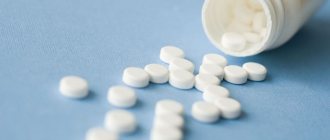Iron burn is a thermal injury that occurs when the skin comes into contact with a heated surface or steam escaping from the internal elements of a household appliance. Injury often occurs in adults, and due to childhood carelessness and inattention of parents, in children as well. To avoid infectious complications, the formation of post-burn scars and scars, it is important to competently provide first aid and follow-up therapy.
Degrees of burns
The first step is to clarify what type of injury you are dealing with.
The causes of iron burns are skin contact directly with a hot surface - the “sole”, as well as hot steam. Iron burns are classified as thermal burns, i.e. skin damage resulting from exposure to high temperatures. They come in 4 degrees of severity:
- First degree burns are characterized by slight redness of the skin, accompanied by burning and peeling of the skin.
- Second-degree burns are accompanied by the formation of blisters filled with a yellowish liquid (exudate). The skin is red and irritated, pain is moderate to severe.
- Third degree burns are serious skin lesions to the full depth, followed by the death of skin particles (outwardly this manifests itself in the form of brown scabs that form at the site of injury).
- Fourth degree burns are the most serious, affecting the muscles and bones. It is almost impossible to get such an injury in a domestic environment.
In addition to identifying the extent of damage, it is important to determine the area of the burn. Doing this yourself is very simple: use your hand as a “measuring device”.
It is believed that the area of skin on the palm is about 1% of the area of the entire skin of the body. Using an iron, carefully measure the area of the burn damage without placing your palm on the damaged area. As a rule, such an injury does not affect more than 1-2% of the skin area.
Why do you need to know this? In case of thermal damage to the skin, it is important to provide first aid as quickly as possible. At home, this can be done only if there is a 1-2 degree burn and no more than 10% of the body is burned, or a 2nd degree burn with no more than 1% of the body area affected. In all other situations, as well as if the victim experiences severe pain, consult a doctor immediately.
Possible consequences
Thermal injuries from an iron are fraught with serious complications. The most common problems can be skin defects - scars or cicatrices that do not heal for several years. Infection is a complication caused by self-puncture of blisters. The affected area, deprived of natural insulation, may fester and therefore require prolonged treatment. In this case, the risk of scar formation increases.
Burns from a hot iron usually cover a small area but can be very deep. Therefore, pain shock cannot be ruled out, especially in a small child. Even a small area of damage sometimes causes loss of consciousness. This condition requires immediate medical attention.
First aid for iron burns
Timely first aid will help speed up further recovery and prevent possible complications. First aid for an iron burn includes the following measures:
- Stopping the traumatic impact – i.e. the victim should be as far away from the iron as possible.
- Cooling the damaged surface - it is best to “substitute” the affected part of the body under a stream of cool water for 15-20 minutes. These actions will reduce pain and limit the area of damage.
- If no blisters appear at the site of the iron burn, then it can be treated with panthenol or another “lifesaver”.
- Next, you need to apply a damp bandage directly to the burn site - a bandage or gauze is suitable for this purpose.
- A victim of an iron burn may experience pain shock: he needs rest, plenty of fluids, and painkillers.
- Further actions depend on the degree of the burn: if blisters appear, it is not recommended to open them to prevent infection. If you suspect that your injury is serious—a third-degree burn or higher—no first aid other than applying a sterile bandage is prohibited. You should immediately contact a medical facility.
How to anoint iron burns?
First of all, remember that you should not smear damaged skin with “whatever comes to hand”: doctors do NOT recommend applying vegetable oils, fats (sour cream, cream, kefir) and other oily substances to the damaged surface. They will only reduce heat transfer and increase the local temperature, which will significantly complicate healing. A place burned by an iron is already not cooling well, and you will make the situation even worse.
If you have been diagnosed with a first or second degree burn, then the damaged area should be wiped with alcohol or a solution of potassium permanganate to disinfect.
To speed up the healing process of iron burns, water-based antibacterial and wound-healing ointments are used.
Unfortunately, iron burns take a long time to heal: dark spots form at the site of damage, and scars may remain. The healing process of a burn is as follows:
- A period of inflammation, which is accompanied by biological processes aimed at eliminating it.
- The renewal period is when the wound cavity begins to fill with new tissue.
- A scar is formed and the wound is covered with new skin.
In order for healing to occur quickly and without complications, an iron burn must be treated. Treatment should be aimed at preventing infection, pain relief, and eliminating infection from the wound. The means used should help improve blood circulation in the damaged area for its speedy healing.
In addition, the skin at the site of an iron burn is highly sensitive and can be dry and irritated. Care for her needs to be effective and at the same time delicate. This is why it is so important to choose the right product.
La-Cri restorative cream is perfect for these purposes. The combination of natural ingredients in the cream allows you to effectively solve various skin problems in a short time. Seed extract copes well with inflammation and itching, violet extract and bisabolol have a calming effect, avocado oil promotes rapid skin regeneration. Apply the cream several times a day until the burn is completely healed - and you will notice how quickly it comes.
On the couch
The situation can be saved, even if you accidentally hit your favorite sofa with the iron. Take lemon and sugar, soak the problem area with them and wait 20-30 minutes. Then wipe the area with a wet cloth. These simple steps will eliminate scorch marks on your sofa upholstery.
Folk remedies
In the arsenal of traditional medicine there are many “grandmother’s” recipes regarding the treatment of burns with an iron. Some of them are not recognized by modern medicine: for example, as mentioned earlier, a burn should not be smeared with sour cream (some do it the “old fashioned way”). The same applies to urine lotions (toxins contained in urine can lead to inflammation, so it is better to refrain from this method).
If you are going to turn to folk remedies, use neutral and safe tips:
- You can apply aloe pulp to the burn site (the leaf is peeled and finely ground). This plant is non-toxic, has good penetrating properties and helps reduce pain.
- You can wash damaged skin with a decoction of linden blossom (the plant is brewed in water in a ratio of 1:10).
- You can apply a cold cabbage leaf to the damaged area - it will cool the skin and reduce inflammation.
- A healing decoction of St. John's wort, calendula, chamomile, nettle and yarrow helps well: 1 teaspoon of each plant is brewed in 2 cups of boiling water, left for 10 hours and the burn is washed with the solution.
- You can apply a compress - a bandage dipped in a soda solution - to the damaged area. Its alkaline composition neutralizes the acidic environment formed on the surface of thermally exposed skin, which means it reduces the risk of burn inflammation.
- It is believed that toothpaste with menthol can reduce the pain from a burn: apply a thin layer to the damaged skin and hold for a while.
On synthetics, polyester
Synthetic items are inexpensive and practical. But they can only be ironed at temperatures up to 80 degrees Celsius. If you violate the heat treatment regime, a synthetic jacket, tracksuit or blouse will instantly burn. There are two ways to eliminate a burn:
- thoroughly wipe the damage with a sponge soaked in ethyl alcohol;
- take an ordinary onion and rub it on the fabric or put onion pulp on them; then wash the item.
- For fresh stains, clean with lemon or lemon juice.
Child's burn
Children, no less often than adults, receive household injuries, including iron burns. As soon as the parent is distracted for a second, the curious kid is already climbing to check “where this steam is coming from.” As a result, the child may be injured, not only by a burn from the iron on his hand, but also on other parts of the body.
The situation is complicated by the fact that a child’s skin is even more delicate and thin than that of an adult, which means that even the slightest damage can take much longer to heal.
If you have any suspicions that your baby has been seriously injured, be sure to consult a doctor and stock up on La Cree cream, which is perfect for children’s sensitive skin. Unlike many similar skin treatment products, all La-Cri products have a non-hormonal composition with natural ingredients. Therefore, they can be used even for infants.
And, of course, remember that the best protection is prevention. When working with the iron, follow safety precautions, do not leave the device turned on unattended, and place it out of the reach of children.
From flax
We're sorry, but it seems you're out of luck. Linen is rarely damaged by ironing. This can only be done through negligence, and then you will have to try hard. The reason for the durability of this material is that flax fibers can withstand temperatures up to 200 degrees Celsius. This is the temperature at which you should iron it.
Here are some effective ways to remove stains from linen.
- Dilute a teaspoon of hydrogen peroxide and a few drops of ammonia in half a glass of water. Soak gauze or cotton pad in this solution. Treat the stain with them. Wait about 5 minutes. and rinse the item. Don't forget to carefully iron the item again.
Please note: when ironing linen should be left slightly damp, or use a sprayer.
- Soak a sponge in soap and rub the scorch mark, then rinse off any remaining soap and iron it again.
Expert opinion
The conducted clinical study proves the high efficiency, safety and tolerability of products for daily skin care of children with mild and moderate forms of atopic dermatitis and during remission, accompanied by a decrease in the quality of life of patients. As a result of therapy, a decrease in the activity of the inflammatory process, a decrease in dryness, itching and flaking was noted.
The properties of the cream for sensitive skin are confirmed by clinical research. This tool:
- reduces itching and irritation;
- relieves skin redness;
- moisturizes and gently cares for the skin.
Sources:
- Fundamentals of health development in children. Textbook. — Moscow: Mir, 2016. — 384 p. Tulchinskaya, V.D. Nursing assistance to children / V.D. Tulchinskaya. - Moscow: Russian State University for the Humanities, 2016. - 368 p.
- Andropova T.V., Gudina M.V., Odintsova I.N., Hygiene of children and adolescents, publishing house: Siberian State Medical University Publishing House, 2022 - 101 p.
- Kovyazina N.A., Fedosimova N.A., Illek Ya. Yu. Diagnosis of atopic dermatitis in young children, Vyatka Medical Bulletin, 2007
- Smirnova G.I. Managing the course of the disease: atopic dermatitis in children, Russian pediatric journal, 2014
Treatment
To choose the right course of rehabilitation, you first need to correctly diagnose the problem. For this purpose, various classifications of burn marks have been invented, the most popular of which is the Vancouver Scar Rating Scale. In Russia it is slightly changed, in accordance with national characteristics:
| Points | Description |
| by color | |
| 0 | the color does not stand out from the overall skin tone |
| 1 | hyper- or hypo-pigmented (the color is either brighter than the base tone or paler) |
| 2 | immature scars - shades of red |
| in relation to the level of surrounding healthy skin | |
| 0 | at the level |
| 1 | below level |
| 2 | above level |
| by relief and surface quality | |
| 0 | flat |
| 1 | uneven, bumpy |
| 2 | with hyperkeratosis and ulcerations |
| according to form | |
| 0 | scar cord or fold (length greater than width) |
| 1 | scar mass (length and width are equal) |
The scores shown in the table indicate the degree of burn. So “0” corresponds to the first degree, “1” to a superficial burn, “2” to a deep or third degree burn.
How to treat which degree
Since the scale of the problem at 3 degrees is different, the treatment will be different:
- To treat a 1st degree burn, homemade applications with a special cream are sufficient, and within a week the damaged area should recover.
- If in grade 1 there is only redness, then in grade 2 there is a burning sensation and blisters. This is still not scary, and the burn can be cured with the same cream, but the course of applications will last 30-40 days. Under no circumstances should you puncture the blisters, as this will inevitably lead to infection of the wound.
- With a 3rd degree burn, swelling, dead skin, scabs, blisters and hyperemia around the wound are observed. In this case, a doctor’s supervision is required, as well as complex treatment with ointment or cream, as well as cosmetic procedures, physiotherapy, and even surgery with skin grafting. The body will recover for at least 2 months.
In any case, scars remain after the injury. How to remove a burn scar depends on how serious it was. The first and second degrees do not leave deep damage, so you can cope with them on your own with the help of physiotherapy and cosmetics. With the third degree it is more difficult - damage can reach the bones, therefore the recovery period will be very long and difficult, it involves surgery and skin grafts.
Find out which scar correction method is optimal for you!
doctor Svetlana Viktorovna Ogorodnikova.
doctor
Cosmetic procedures
According to dermatologists, treatment of scars and marks after a burn should begin only when the wound has completely healed and a scar has formed. Starting earlier can only make the problem worse. What solutions will be offered in the beauty salon:
- Chemical peeling . A substance enriched with fruit acids is applied to the scar. It corrodes the “wrong” stratum corneum of the epidermis, due to which the scar softens and evens out relative to the overall skin texture.
- Laser peeling. Popular against facial scars. As cosmetologists assure, the process is safe and effective. The rough scar is carefully “cut off” by the laser beam, leaving new soft skin underneath.
- Silicone sheets and gels prevent the growth of scar tissue due to pressure. This method is effective at the beginning of scar tissue formation.
- Diamond grinding. A type of peeling - microcrystals are placed in a special device, which during operation exfoliate the stratum corneum of the epidermis with sharp edges (let us explain: it consists of dead cells and prevents harmful substances from entering the body). This way you can remove burn marks that are quite large in area.
- Glucocorticoid injections. They are mainly used against keloid scars, but there is a high probability of side effects. The drug is injected directly into the scar.
In addition to the listed procedures, physiotherapy helps get rid of scars - courses based on physical influence: with the help of ultrasound or electrophoresis, drug particles penetrate much deeper than they could with a conventional application.
Physiotherapy
Physiotherapy is effective for correcting both fresh scars and old ones. To achieve visible results, it is very important to choose the right medication.
What procedures are classified as physiotherapy?
- Magnetotherapy. Improves blood supply to the scar and the mental state of the victim after injury.
- Phonophoresis. Resolves scar tissue, increases the elasticity of connective tissue, stimulates blood and lymph circulation and metabolic processes, including intracellular metabolism, enhances the production of biologically active substances and the activity of enzyme systems.
- Laser therapy. Accelerates tissue regeneration, calms nerves, and has an anti-inflammatory effect.
- Electrophoresis. The therapeutic effect consists of a simultaneous positive effect on the body of electric current and active charged molecules of the medicinal substance. A drug depot (reserve) is created in the skin and subcutaneous fat, significantly increasing the exposure time of the drugs.
The speed of recovery depends not only on properly selected rehabilitation, but also on cosmetics and medications used during the course.

